"As the demand for all-weather protection on aircraft for unimpaired and continuous commercial and military service developed, the detrimental effects of propeller icing on airplane performance became increasingly important"
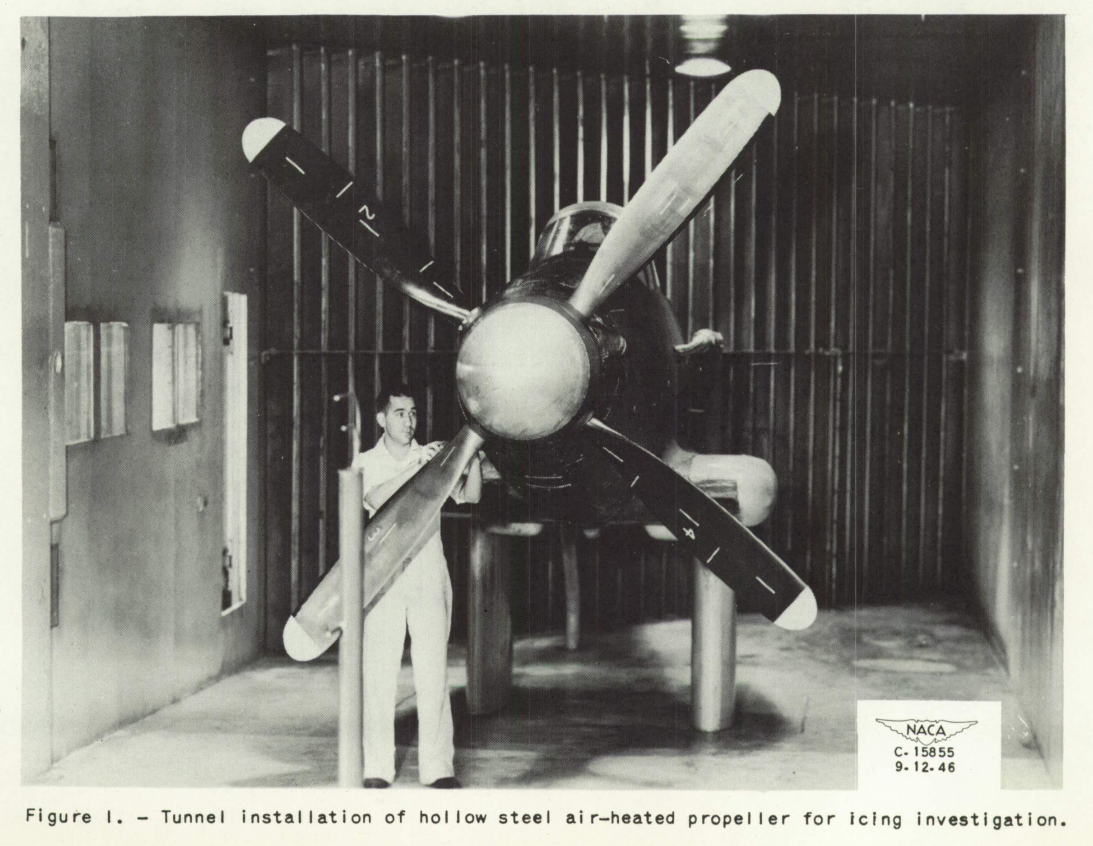
I believe that this is Porter Perkins, circa 1946.
Summary
Porter Perkins investigations of propeller icing are reviewed. These are the earliest investigations by him that I found.
Discussion
Two areas are discussed, the gas heating of propellers, and the measurement of thrust.
Gas heating of propellers
- Investigation of Effectiveness of Air-Heating a Hollow Steel Propeller for Protection against Icing, I - Unpartitioned Blades. NACA-TN-1586, 1948. 1
- Investigation of Effectiveness of Air-Heating a Hollow Steel Propeller for Protection against Icing, II- 50-Percent Partitioned Blades. NACA-TN-1587, 1948. 2
- Investigation of Effectiveness of Air-Heating a Hollow Steel Propeller for Protection against Icing, III - 25-Percent Partitioned Blades. NACA-TN-1588, 1948. 3
SUMMARY
An investigation to determine the effectiveness of icing protection afforded by air-heating hollow steel unpartitioned propeller blades has been conducted In the NACA Cleveland icing research tunnel. The propeller used was a production model modified with blade shank and tip openings to permit internal passage of heated air. Blade-surface and heated-air temperatures were obtained and photographic observations of ice formations were made with variations in icing intensity and heating rate to the blades.
The complete research program involved investigation of air-heating (1) fully hollow unpartitioned propeller blades, (2) propeller blades partitioned to confine the air flow to the forward one-half of the blade cavity, and (3) propeller blades partitioned to confine the air flow to the forward one-fourth of the blade Cavity.
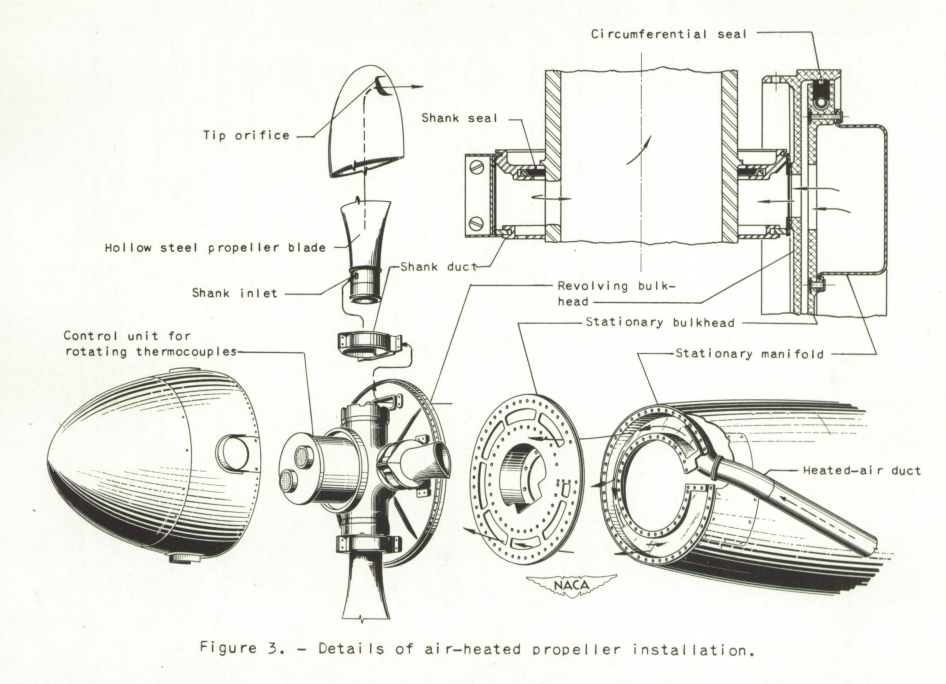
For the conditions of Icing to which the propeller was subjected, it was found that adequate ice protection was afforded with a heating rate of 40,000 Btu per hour per blade. With less than 40,000 Btu per hour per blade, ice protection failed because of significant ice accretions on the leading edge. The chordwise distribution of heat was unsatisfactory with most of the available heat dissipated well back of the leading edge on both the thrust and camber face's instead of at the leading edge where it was most needed. A low utilization of available heat for icing protection is indicated by a heat-exchanger effectiveness of approximately 47 percent.
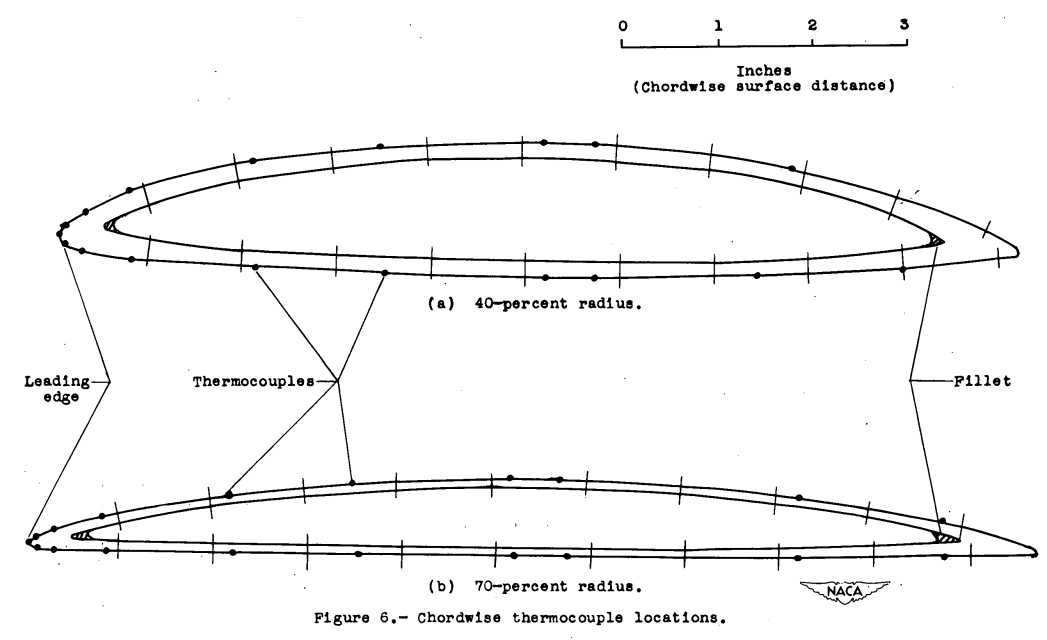
With 50-percent partitioning of the blades, adequate icing protection at 1050 rpm was obtained with a heating rate of 26,000 Btu per hour per blade at the blade shank using an air temperature of 4000 F with a flow rate of 280 pounds per hour per blade, which is one-third less heat than was found necessary for similar ice protection with unpartitioned blades. The chordwise distribution of the applied heat, as determined by surface temperature measurements, was considered unsatisfactory with much of the heat dissipated well back of the leading edge. Heat-exchanger effectiveness of approximately 56 percent also indicated poor utilization of available heat. This effectiveness was, however, 9 percent greater than that obtained from unpartitioned blades.
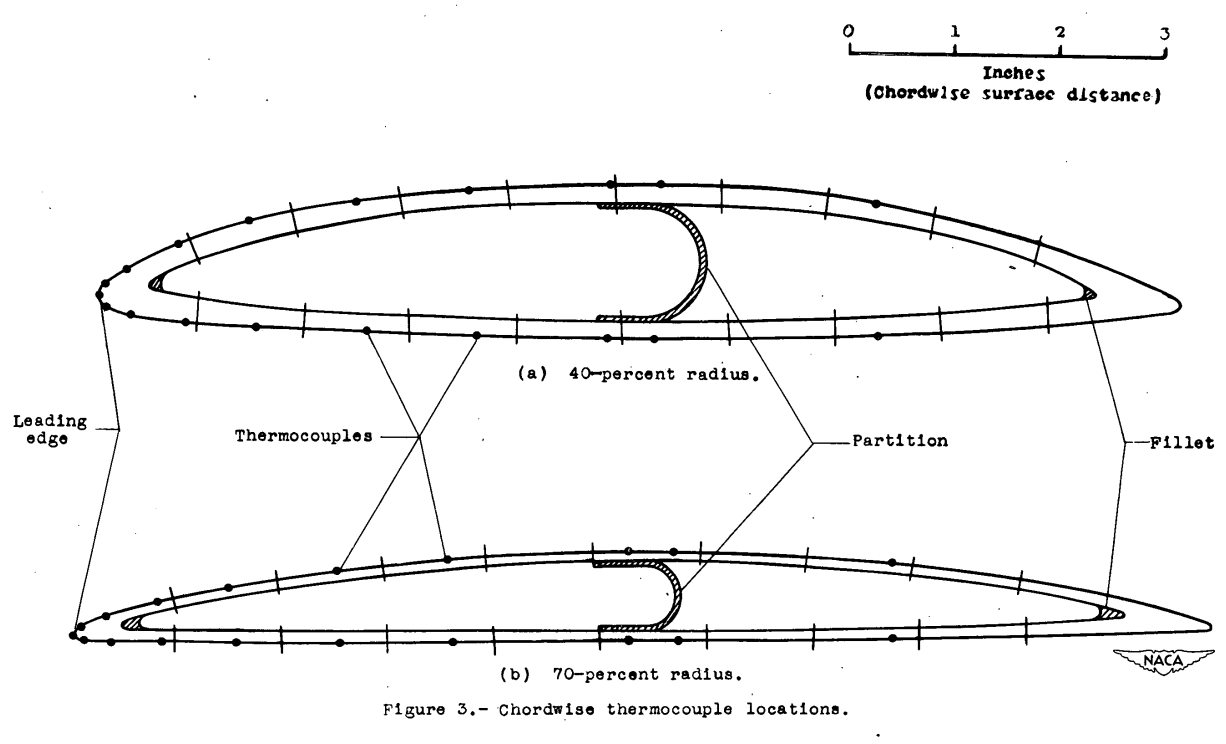
Surface temperature measurements indicated that confining the heated air forward of the 25-percent chord gave a more economical distribution of the applied heat as compared with unpartitioned and 50-percent partitioned blades, by dissipating a greater percentage of the available heat at the leading edge. At a propeller speed of 850 rpm, a heating rate of 7000 Btu per hour per blade at a shank air temperature of 400 F provided adequate icing protection at ambient-air temperatures of 230 F but not at temperatures as low as 150 F. With the heating rate used, a heat-exchanger effectiveness of 77 percent was obtained as compared to 56 percent for 50-percent partitioned and 47 percent for unpartitioned blades.

CONCLUSIONS
The high heat-exchanger effectiveness associated with the 25-percent partitioned blades and the lower heat-input rate required as compared to the unpartitioned and 50-percent partitioned blades indicate that partitioning the cavity at approximately 25-percent. chord provides the most economical method of those examined for air-heating propeller blades. If heat were supplied to the blade at a sufficient rate to maintain satisfactory leading-edge temperatures and surface temperatures near the rear of the blade were not raised adequately to prevent runback icing under all conditions, part of the heated air could be bled to the rear chamber through orifices in the partition without destroying the concentration of heat at the leading edge.
Measurement of thrust
"Measurement of propeller thrust during icing conditions is essential to determine the aerodynamic effects of ice formations on propellers or to evaluate the effectiveness of ice-protection methods."
- An Electric Meter Suitable for Flight Investigation of Propellers. NACA-RM-E9C17, 1949. 4
SUMMARY
A lightweight instrument that utilizes resistance-wire electric strain gages to measure propeller-shaft thrust has been developed. A wind-tunnel investigation on a propeller installed, on a single-engine pursuit airplane showed that the instrument gave a reliable indication of propeller-shaft thrust to an accuracy of ±2 percent within its calibrated range. No attempt was made to determine the relation of indicated shaft thrust to net propeller thrust.
INTRODUCTION
Measurement of propeller thrust during icing conditions is essential to determine the aerodynamic effects of Ice formations on propellers or to evaluate the effectiveness of ice-protection methods. An investigation in the 16-foot tunnel at the NACA Langley laboratory showed no serious effects on propeller performance of an artificial simulation of ice on the blades (reference 1). An exact measure of the effect of the propeller alone can be obtained from propeller thrust measurements with and without ice protection during icing conditions. Other conditions being equal, the net change in thrust caused by ice formations is indicated by a change in propeller-shaft thrust.
An investigation of propeller-icing effects and various systems of thermal ice protection has been made under simulated icing conditions in the icing research tunnel at the NACA Lewis laboratory. The need for an accurate device to measure propeller thrust and especially to measure incremental changes in thrust due to ice formations, when other conditions remain constant, led to the construction of a thrust meter of an electric strain-gage type to be installed on the propeller shaft; the thrust meter utilizes an electric circuit similar to that of the NACA electric torquemeter described in reference 2.
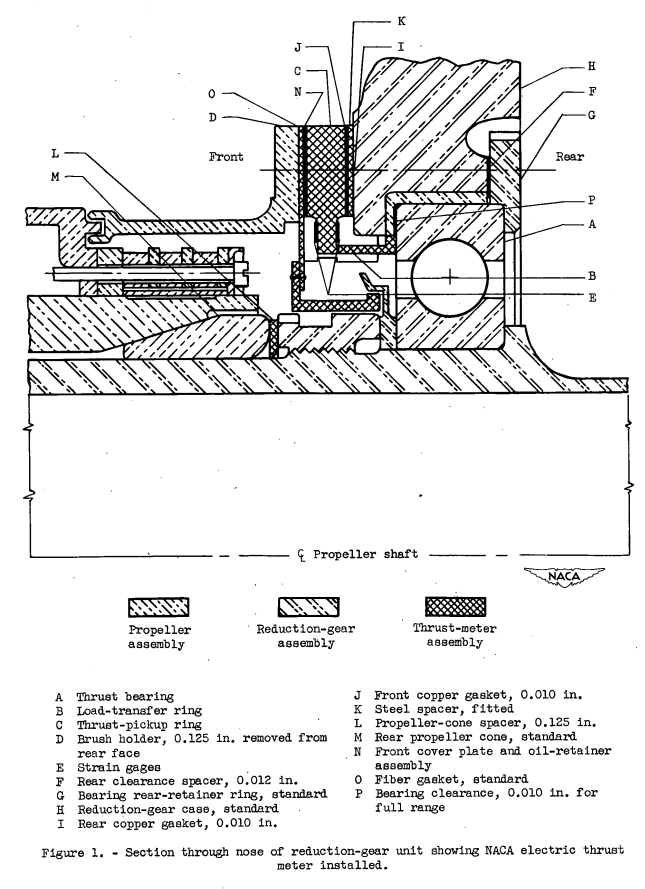
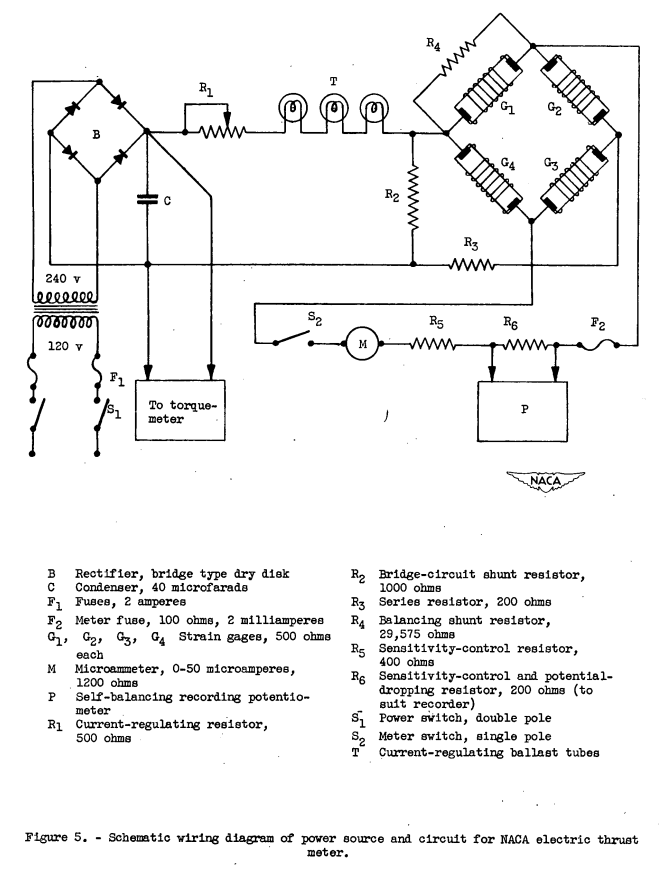
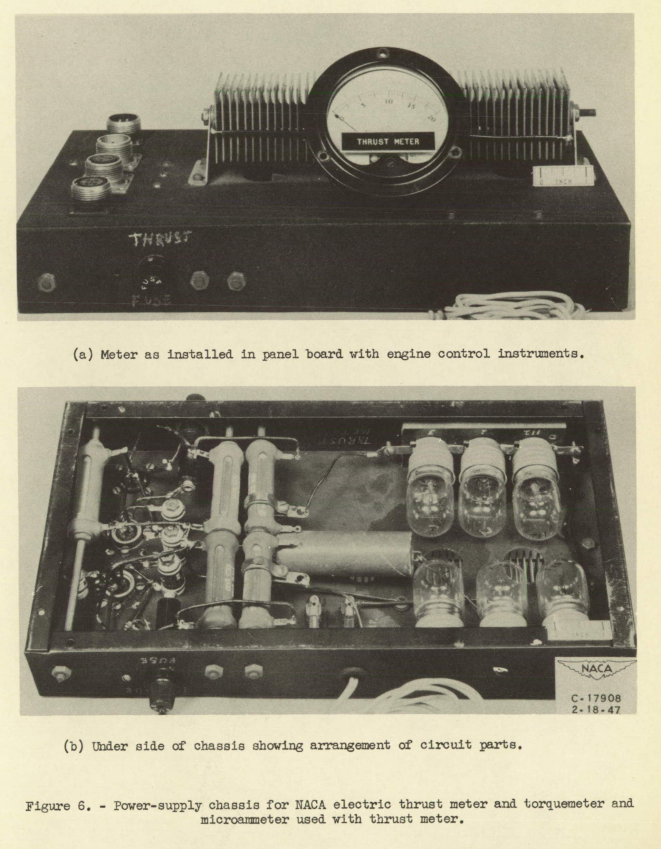

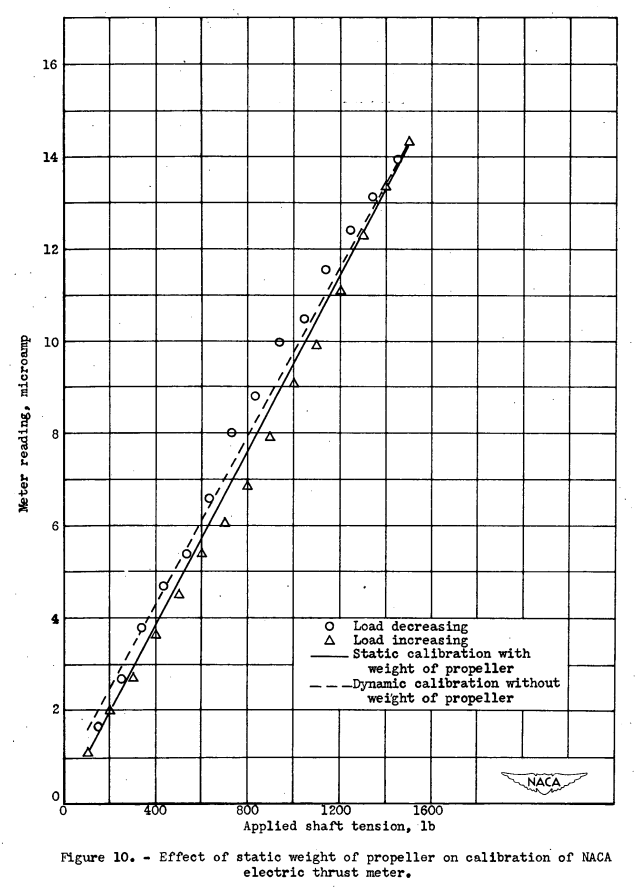
CONCLUSIONS
Results of a tunnel investigation of the electric propeller-shaft thrust meter installed on a single-engine pursuit airplane show that the meter reliably indicates propeller-shaft thrust with an accuracy of ±2 percent within its calibrated range. Measurement of propeller-shaft thrust with this type of instrument is useful in determining for a given installation the relative effects on thrust of various blade-surface-roughness conditions resulting from ice formations.
Conclusions
I believe that test experience in the icing tunnel was valuable later in his career, and the thrust meter experience was valuable for later icing instrument designs. Such experiences were valuable in my career.
Citations
scholar.google.com found the publications cited:
NACA-TN-1586 7 times
NACA-TN-1587 6 times
NACA-TN-1588 zero times
NACA-RM-E9C17 zero times
Related
NACA-TN-1568 is mentioned in Calibration of the NACA Icing Wind Tunnels, and Uses of NACA-Era Icing Wind Tunnels.
This is part of the Porter Perkins series.
Notes
-
Mulholland, Donald R., and Perkins, Porter J.: Investigation of Effectiveness of Air-Heating a Hollow Steel Propeller for Protection against Icing, I - Unpartitioned Blades. NACA-TN-1586, 1948. ntrs.nasa.gov ↩↩
-
Perkins, Porter J., and Mulholland, Donald R.: Investigation of Effectiveness of Air-Heating a Hollow Steel Propeller for Protection against Icing, II- 50-Percent Partitioned Blades. NACA-TN-1587, 1948. ntrs.nasa.gov ↩
-
Mulholland, Donald R., and Perkins, Porter J.: Investigation of Effectiveness of Air-Heating a Hollow Steel Propeller for Protection against Icing, III - 25-Percent Partitioned Blades. NACA-TN-1588, 1948. ntrs.nasa.gov ↩
-
Perkins, Porter J., and Millenson, M. B.: An Electric Meter Suitable for Flight Investigation of Propellers. NACA-RM-E9C17, 1949. ntrs.nasa.gov ↩